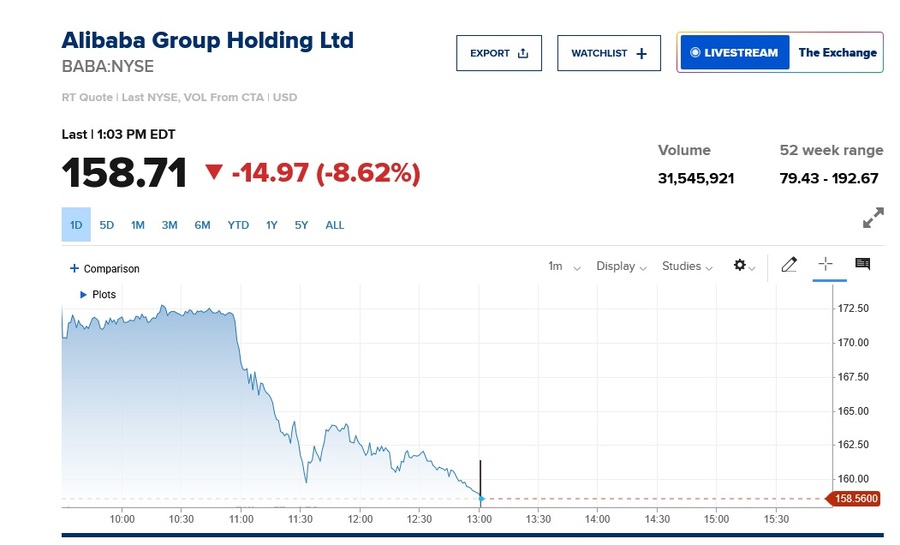Lasogette
Supremacy Member
- Joined
- Dec 20, 2012
- Messages
- 8,166
- Reaction score
- 4,529
Bro
U got pay $2?Wlwlsmdwl Bro wongminmin!!!

U got pay $2?Wlwlsmdwl Bro wongminmin!!!
$2 for what Bro Lasogette???Bro
U got pay $2?
To watch the secret videos on YouTube ?$2 for what Bro Lasogette???
$2 or $20 for his membership!!!!$2 for what Bro Lasogette???
He has been saying that for long time.But he said US ish overpriced Bro boxer33!!!
Oh for Master Leong Bro Lasogette???To watch the secret videos on YouTube ?
Nonono Bro wongminmin!!!$2 or $20 for his membership!!!!
chiu fake fan. Bro Crimson!!!
That ish very true Bro boxer33!!!He has been saying that for long time.
People already huat big big from US stocks esp TSLA, PLTR, NVDA
Just like saying last time 4 rm hdb 300k overpriced don't buy but now 500k alr.
What happened Bro homer123???hongkan liao ..goondu master baba going to chibaboom again

That ish very true Bro mooseolly!!!Buy the dip?
China's Solid Exports & Trade War Resilience
Right off the bat, Leong tells everyone not to be too fearful about the huge sell-off in the Hong Kong market and to focus on the fundamentals. The big news is that China's export data for September was surprisingly good!
- The Numbers: Chinese exports grew at the fastest rate in six months, beating expectations. The data showed exports rose by 8.3% and imports increased by over 7%. As Leong puts it, "China is selling to the rest of the world. We don't have to be worried."
- The US vs. The World: While exports to the US fell significantly (by 27% year-over-year) due to high tariffs, China more than made up for it elsewhere. Exports to places like Europe, Southeast Asia, and Africa are all "growing in double digits."
- Notable Quote: The US is becoming a smaller piece of the puzzle. Leong notes, "US only accounts for less than 10% of China's direct export. So 10% is not a lot really." He feels China is in a "very comfortable position" to negotiate and will survive even if they sell nothing to the US.
Stock Talk: Buying the JD & BYD Dip
After talking about the strong economic data, the discussion shifts to the tech stocks that got hit hard during the sell-off, specifically Alibaba, JD, and BYD. Leong shares his personal strategy and thoughts on these companies.
- Personal Strategy: Leong mentions that he has mainly been buying into JD and BYD this year. He's very transparent about his own portfolio, stating, "now both my BYD and JD the position is in red already."
- Advice for Followers: For those who want to follow his moves, Leong shares his potential entry prices, suggesting they could buy "BYD $15 level or JD $126 level." He cautions that the market's direction is unpredictable because "it all depends on Donald Trump," and that there could be another 5% to 10% pullback.
- Conviction is Key: The ultimate advice is to be decisive. If you have conviction in these companies, it might be a good time to get in. If not, it's better to "just wait for the earning season," which is starting next week.
CATL: The Undisputed Market Leader
Leong introduces CATL (3750) as the dominant force in EV batteries, controlling the entire supply chain from mining to recycling. This makes them the lowest-cost producer and a global leader with customers like BMW, VW, and Toyota.
- Key Stat: CATL holds a 38.1% global market share.
- Notable Quote: "As long as you are in the EV industry, you have to get the battery from them."
An Industry Consolidating Around Giants
The EV battery market has shifted from Japanese/Korean players to a Chinese duopoly of CATL and BYD. Leong predicts most smaller players will fail due to massive R&D costs and the critical importance of safety, which favors established leaders.
- Key Stat: Together, CATL and BYD control over 50% of the market.
- Notable Quote: "This industry only the top three will survive. Maybe in the end it becomes a dual poly only."
Strong Financials and Widening Margins
Leong highlights CATL's impressive financial health. Earnings growth (32%) is far outpacing revenue growth (7%), proving they are becoming more efficient and profitable as their production costs fall.
- Key Stat: The gross margin on their EV batteries has expanded to 22%.
- Notable Quote: "They're becoming more and more profitable."
Valuation: Great Company, Overvalued Stock
Despite CATL's strengths, Leong's verdict is clear: the stock is "very overvalued." He argues its 2 trillion HKD market cap is double that of the more diversified BYD, which makes no sense. He advises against chasing the stock at its current price.
- Key Stat: He would only consider buying if the price drops by 50%, bringing its market cap down to 1 trillion HKD.
- Notable Quote: "Don't for[mo] don't chase... it's overvalued."
The Real "Moat" is the Battery
Leong's core investment thesis is that the true competitive advantage in the EV industry lies in battery technology, not car brands like NIO or XPeng. He classifies CATL and BYD as the only "tier one" players, as all other manufacturers are dependent on them, giving them long-term pricing power.
- Notable Quote: "The competitive advantage of the EV car... is battery. Battery is a clear competitive advantage."
"A lot of people see as danger but I see it as opportunity."
"If you don't dare to buy BYD, then you shouldn't be in the Hong Kong market... Be greedy when others are fearful."

Is BYD the next Evergrande?Did he deep dive on why legendary investor Warren Buffet got out of BYD while he went in??